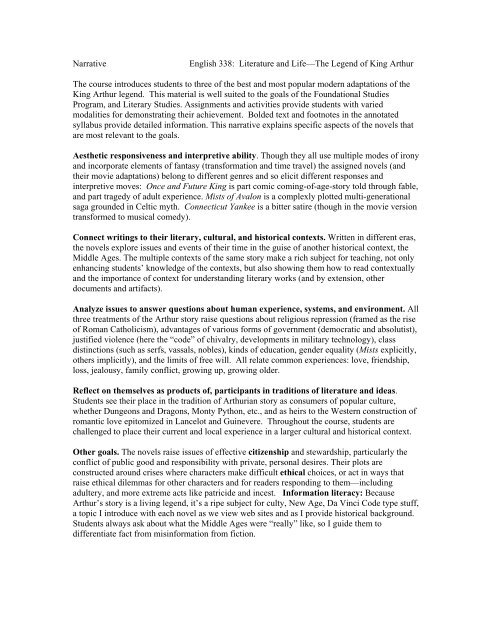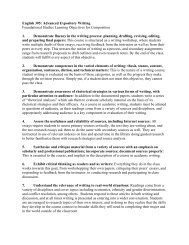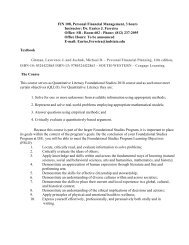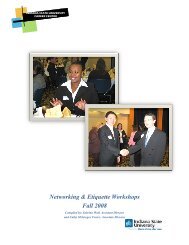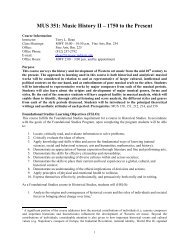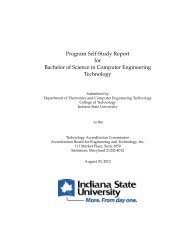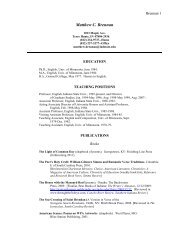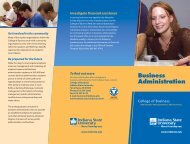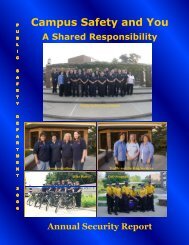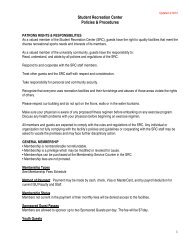English 338 - Indiana State University
English 338 - Indiana State University
English 338 - Indiana State University
Create successful ePaper yourself
Turn your PDF publications into a flip-book with our unique Google optimized e-Paper software.
Narrative<br />
<strong>English</strong> <strong>338</strong>: Literature and Life—The Legend of King Arthur<br />
The course introduces students to three of the best and most popular modern adaptations of the<br />
King Arthur legend. This material is well suited to the goals of the Foundational Studies<br />
Program, and Literary Studies. Assignments and activities provide students with varied<br />
modalities for demonstrating their achievement. Bolded text and footnotes in the annotated<br />
syllabus provide detailed information. This narrative explains specific aspects of the novels that<br />
are most relevant to the goals.<br />
Aesthetic responsiveness and interpretive ability. Though they all use multiple modes of irony<br />
and incorporate elements of fantasy (transformation and time travel) the assigned novels (and<br />
their movie adaptations) belong to different genres and so elicit different responses and<br />
interpretive moves: Once and Future King is part comic coming-of-age-story told through fable,<br />
and part tragedy of adult experience. Mists of Avalon is a complexly plotted multi-generational<br />
saga grounded in Celtic myth. Connecticut Yankee is a bitter satire (though in the movie version<br />
transformed to musical comedy).<br />
Connect writings to their literary, cultural, and historical contexts. Written in different eras,<br />
the novels explore issues and events of their time in the guise of another historical context, the<br />
Middle Ages. The multiple contexts of the same story make a rich subject for teaching, not only<br />
enhancing students’ knowledge of the contexts, but also showing them how to read contextually<br />
and the importance of context for understanding literary works (and by extension, other<br />
documents and artifacts).<br />
Analyze issues to answer questions about human experience, systems, and environment. All<br />
three treatments of the Arthur story raise questions about religious repression (framed as the rise<br />
of Roman Catholicism), advantages of various forms of government (democratic and absolutist),<br />
justified violence (here the “code” of chivalry, developments in military technology), class<br />
distinctions (such as serfs, vassals, nobles), kinds of education, gender equality (Mists explicitly,<br />
others implicitly), and the limits of free will. All relate common experiences: love, friendship,<br />
loss, jealousy, family conflict, growing up, growing older.<br />
Reflect on themselves as products of, participants in traditions of literature and ideas.<br />
Students see their place in the tradition of Arthurian story as consumers of popular culture,<br />
whether Dungeons and Dragons, Monty Python, etc., and as heirs to the Western construction of<br />
romantic love epitomized in Lancelot and Guinevere. Throughout the course, students are<br />
challenged to place their current and local experience in a larger cultural and historical context.<br />
Other goals. The novels raise issues of effective citizenship and stewardship, particularly the<br />
conflict of public good and responsibility with private, personal desires. Their plots are<br />
constructed around crises where characters make difficult ethical choices, or act in ways that<br />
raise ethical dilemmas for other characters and for readers responding to them—including<br />
adultery, and more extreme acts like patricide and incest. Information literacy: Because<br />
Arthur’s story is a living legend, it’s a ripe subject for culty, New Age, Da Vinci Code type stuff,<br />
a topic I introduce with each novel as we view web sites and as I provide historical background.<br />
Students always ask about what the Middle Ages were “really” like, so I guide them to<br />
differentiate fact from misinformation from fiction.
Syllabus <strong>English</strong> <strong>338</strong>: Literature and Life—the Legend of King Arthur<br />
Fall 2009 T-R 12:30-1:45, Stalker Hall 301<br />
I. Contact Information<br />
Professor: Harriet Hudson Phone: office: 237-2784, home 232-4568<br />
Office: Stalker 200<br />
E-mail: hhudson@isugw.indstate.edu<br />
Office hours: T-R 11:30-12:15 and by appointment<br />
II. Required Texts<br />
Marion Zimmer Bradley. The Mists of Avalon. Del Ray Books, Ballantine: New York,<br />
1982.<br />
Mark Twain. A Connecticut Yankee in King Arthur’s Court. Signet Classics, Penguin:<br />
New York, 2004<br />
T.H. White. The Once and Future King. Ace: New York, 1996.<br />
III. Course Description<br />
The story of King Arthur is one of the European Middle Ages’ great<br />
contributions to world literature and culture. Like the plays of Shakespeare or the<br />
art of Michelangelo, it continues to speak to people of all times and places. It<br />
contains a great tragic love story—always a good subject (Lancelot and Guinevere)—and<br />
a tragic friendship (Lancelot and Arthur). But these more private relationships assume<br />
significance because the characters are public people—kings and queens and nobles.<br />
One of the most enduring features of the Arthurian legend is the Round Table, a symbol<br />
of the civic ideals of knighthood and the way Arthur governs his realm. The fall of the<br />
Round Table and the civilization that Arthur has built at Camelot raises questions<br />
about loyalty, love, friendship, marriage, raising children, public and private<br />
responsibility, leadership, what constitutes a good government, when war is<br />
justified, what it means to be civilized, the relationship of church and state,<br />
determinism (fate) and free will, and many more issues that concern us today.<br />
There are many versions of the Arthurian story. The greatest <strong>English</strong> version<br />
was written by Thomas Malory in the fifteenth century, as the Middle Ages came to<br />
a tumultuous close. Most later treatments of the legend are based on his Morte<br />
D’Arthur (The Death of Arthur). We will begin by reading brief selections from this<br />
lengthy work that deal with Arthur’s birth and claim to the throne, and his death and the<br />
destruction of the Round Table. Then, starting with the version closest to Malory’s<br />
retelling, we will read T.H. White’s The Once and Future King. This was first<br />
published in 1938 as the rise of Fascism and the onset of World War II threatened<br />
the values of western civilization that Arthur’s legend exemplifies. Next we will read<br />
Marion Zimmer Bradley’s Mists of Avalon, published in 1982. This presents the<br />
story from the perspective of the legend’s female characters and the culture of the<br />
Celts that gave birth to the Arthurian legend in the 6 th century. It reflects the<br />
feminism and multi-culturalism of the late 20 th century. Last we will read Mark<br />
Twain’s A Connecticut Yankee in King Arthur’s Court, published 1889, where the<br />
Arthurian setting is a vehicle for exploring such 19 th century American concerns as<br />
slavery, democracy, the industrial revolution, and the nature of progress. Through
these different treatments of the legend we will examine the enduring questions it raises<br />
about, modern authors’ uses of historical legend to explore the issues confronting<br />
their own times, and the insights their different treatments of it provide into our<br />
own lives, public and private.<br />
IV. Learning Objectives<br />
This course fulfills a Foundational Studies requirement for a course in Literary Studies. It<br />
is designed to meet the following goals and objectives which are included here to help<br />
you better understand what I expect you to learn from the class.<br />
Program Goals: The Foundational Studies program is designed so that ISU graduates<br />
can analyze problems, think critically and creatively, integrate a variety of approaches to<br />
gain knowledge, recognize the ethical, social, and cultural implications of issues, and<br />
communicate professionally, persuasively and effectively.<br />
Program Objectives—Students will:<br />
• Locate, critically read, and evaluate information to solve problems;<br />
• Critically evaluate the ideas of others;<br />
• Apply knowledge and skills within and across the fundamental ways of knowing<br />
(natural sciences, social and behavioral sciences, arts and humanities,<br />
mathematics and history);<br />
• Demonstrate an appreciation of human expression through literature and fine and<br />
performing arts;<br />
• Demonstrate the skills for effective citizenship and stewardship;<br />
• Demonstrate an understanding of diverse cultures within and across societies;<br />
• Demonstrate the skills to place their current and local experience in a global,<br />
cultural, and historical context;<br />
• Demonstrate an understanding of the ethical implications of decisions and actions<br />
• Apply principles of physical and emotional health to wellness;<br />
• Express themselves effectively, professionally, and persuasively both orally and<br />
in writing.<br />
Literary Studies Goals—Students will:<br />
• Demonstrate aesthetic responsiveness and interpretive ability.<br />
• Connect writings to their literary, cultural, and historical contexts.<br />
• Employ literature to analyze issues and answer questions relating to human<br />
experience, systems, and the physical environment.<br />
• Reflect on themselves as products of and participants in traditions of literature and<br />
ideas.<br />
Course Goals (This is in addition to the others; it’s my goal for you in this course)<br />
• Students will know the history, plot, and main characters of the Arthurian legend<br />
V. Class Policies<br />
You are expected to attend class, prepare by keeping up with reading assignments,<br />
participate in class discussions, and hand in assignments on time.<br />
Attendance: I take attendance regularly. If you miss more than 3 classes I may lower<br />
your final grade by a letter for each additional absence. If you know you will
have to be absent, if possible, let me know in advance and bring verification<br />
(doctor’s slip, letter from coach or professor).<br />
Courtesy: Turn off cell phones in class.<br />
Use your laptop only as directed by the instructor.<br />
Do not sleep, read newspapers, magazines, or materials for other courses.<br />
Arrive on time and remain in the room until class is dismissed.<br />
Assignments: No make-up quizzes will be given. Make up exams are at my discretion,<br />
and require prior arrangement. Written work must be turned on the announced<br />
date. I will not accept late papers.<br />
Academic Honesty: I can not give you credit for work that is not your own. Plagiarism<br />
and other forms of cheating will not be tolerated. Depending of the nature of the<br />
assignment and the seriousness of the offense, penalties range from no credit<br />
given for the assignment, to a failing grade in the course, to suspension or<br />
expulsion as determined by Student Judicial Programs. Consult your copy of The<br />
Code of Student Conduct for more information about the <strong>University</strong>’s policy<br />
on academic integrity.<br />
<strong>University</strong> Policies: The <strong>University</strong> has policies regarding academic freedom, students<br />
with disabilities and other matters. These apply to this class and may be found on<br />
the Gen Ed web page at: <strong>University</strong>Standards<br />
www.indstate.edu/gened/docs/Foundational%20Studies/Info%20on%20Sycamore%20St<br />
andard%20and%20ADA%20and%20Laptops%20and%20Academic%20Freedom.pdf.<br />
VI. Assignments and Grading<br />
• Midterm 20%<br />
• Final 20% – this will cover material from the second half of the semester only.<br />
These exams will test your reading through objective questions and your<br />
critical thinking and writing through essays.<br />
• Reading quizzes 20%– generally these will be given weekly. Their purpose is to<br />
help you keep up with the reading and to let us both know if you are getting the<br />
important points.<br />
• 2 Essays 15% each – minimum 4 pages. 1 You’ll write essays on two of the three<br />
assigned books. You can develop your own topic, but it will need to analyze<br />
some aspect of the work in terms of its cultural or historical context, its<br />
treatment of social issues, or common human experiences.<br />
• Participation in class discussion 10 % – I’ll give you questions to guide your<br />
reading and form a basis for our class discussions. 2 I’ll also assign you days to<br />
pick passages from the assigned reading and explain their importance in class.<br />
1 Developmental writing: Students submit one-paragraph proposals of paper topics for my approval, and I<br />
require drafts of papers before I will accept final versions. This allows for feedback, encourages timeliness<br />
and academic integrity, and doesn’t take that much more total time for grading.<br />
2 These questions focus on important themes in the works and are directly related to the four Literary<br />
Studies goals. These themes will be topics of essay questions on the exams and of papers. They are listed<br />
in the annotations to the Class Schedule and Reading Assignments. The discussions and passage<br />
presentations encourage effective oral communication, and courteous but critical evaluation of classmates’,<br />
authors’ and the instructor’s ideas.
These activities will enhance your reading and communication skills, as well<br />
as help you develop ideas for your papers.<br />
Class Schedule and Reading Assignments<br />
1. Aug. 26 Introduction<br />
2. Sept. 1 History of the Arthurian Legend, Selections from Le Morte D’ Arthur 3<br />
Sept. 3 Once and Future King: Book I, The Sword in the Stone 4<br />
3. Sept. 8 The Sword in the Stone<br />
Sept. 10 Once and Future King: Book II, The Queen of Air and Darkness<br />
4. Sept. 15 The Queen of Air and Darkness<br />
Sept. 17 Once and Future King: Book III, The Ill-Made Knight<br />
5. Sept. 22 The Ill-Made Knight<br />
Sept. 24 Once and Future King: Book IV, The Candle in the Wind<br />
6. Sept. 29 The Candle in the Wind<br />
Oct. 1 Movies (Once and Future King, Camelot) 5<br />
7. Oct. 6 Conclusion Once and Future King, Review<br />
Once and Future King essay due<br />
Oct. 8 Midterm<br />
3<br />
Introduction to Arthurian legend and history, and to Celtic culture and myth (Oct. 13) incorporate<br />
websites for pictures of places and artifacts, also some attention to distinguishing sound information and<br />
credible websites from less reliable ones.<br />
4 Discussion topics for Once and Future King include: education and nurture; ethical and appropriate uses<br />
of authority, including law and military might; systems of government and social organization (fascism,<br />
socialism, monarchy, democracy); ethnic (tribal) identity; gender roles; treatment of animals; love,<br />
friendship, marriage; public responsibility versus personal preference; tragic plot structure. Students are<br />
asked to consider both what the work has to say about these themes, and how what is said relates to their<br />
own experiences.<br />
5 Viewings of selected scenes from movies based on all three novels give students a chance to see further<br />
adaptations of the Arthurian legend, and to consider the implications of genre and medium in presenting the<br />
story. “The Sword in the Stone” is a Disney animation. “Camelot” and “Connecticut Yankee” are<br />
musicals from 1940s and 1960’s; “Mists of Avalon” is a historical fantasy drama. Discussion focuses on<br />
adaptation and aesthetic response.
8. Oct. 13 Avalon and Glastonbury: Arthur’s Celtic roots<br />
Oct. 15 Mists of Avalon: Book I, Mistress of Magic 6<br />
9. Oct. 20 Mistress of Magic<br />
Oct. 22 Mists of Avalon: Book II, The High Queen<br />
10. Oct. 27 The High Queen<br />
Oct. 29 Mists of Avalon: Book III, The King Stag<br />
11. Nov. 3 The King Stag<br />
Nov. 5 Mists of Avalon: Book IV, The Prisoner in the Oak<br />
12. Nov. 10 The Prisoner in the Oak<br />
Nov. 12 Conclusion Mists of Avalon, Movie (Mists of Avalon)<br />
Mists of Avalon essay due<br />
13. Nov. 17 American Gothic: History and culture of the late 19 th century 7<br />
Nov. 19 A Connecticut Yankee in King Arthur’s Court chapt. 1-15 8<br />
14. Nov. 24 Connecticut Yankee chapt. 16-26<br />
15. Dec. 1 Connecticut Yankee chapt. 27-38<br />
Dec. 3 Connecticut Yankee chapt. 39- end<br />
16. Dec. 8 Movie (Connecticut Yankee)<br />
Dec. 10 Conclusions and Review<br />
Final Exam: Tuesday Dec. 15, 1:00<br />
Connecticut Yankee essay due by Thursday, Dec. 17<br />
6 Discussion topics for Mists of Avalon include: gender roles (matriarchy, patriarchy); religion (Christians<br />
versus Druids), the individual, and the state; public responsibility versus personal preference; cultural<br />
conflict; ethical use of knowledge; fate (determinism) and free will; magic and science; archetypal<br />
patterns of myths and ritual. Students are asked to consider both what the work has to say about these<br />
themes, and how what is said relates to their own experiences.<br />
7 Introduction to Connecticut Yankee includes information and images from websites to familiarize<br />
students with Gothic Revival style popular in late 19 th century, also Twain’s references to contemporary<br />
events, technology, and people (J.P. Morgan, Industrial Revolution).<br />
8 Discussion topics for Connecticut Yankee include: nature of “progress”; impact of the industrial<br />
revolution; ethical uses of technology, including warfare; forms of government (democracy, monarchy);<br />
individualism; justice and legal authority; positive and negative views of human nature; class systems<br />
(slavery, hereditary aristocracy, meritocracy); education; forms and functions of satire. Students are asked<br />
to consider both what the work has to say about these themes, and how what is said relates to their own<br />
experiences


